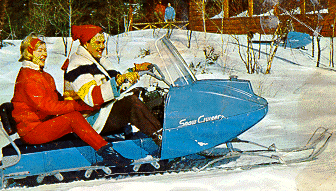Post by sledrat on Jan 27, 2012 6:56:21 GMT -5

Joseph Armand Bombardier dreamed of developing a fast, lightweight snowmobile that could carry one or two people. In the early 1950s, Armand set aside his dream to focus on developing his company's other tracked vehicles. But by the end of the decade, smaller, more efficient engines had been developed and were starting to come on the market. Armand resumed his efforts to build a "miniature" snowmobile. He worked alongside his eldest son Germain, who shared his father's mechanical talents. Armand and Germain developed several prototypes of the lightweight snowmobile and finally, the first Bombardier snowmobile went on sale in 1959.
Bombardier BR180 snowcat pulling snowmobile trail groomer attachment
The Ski-Doo was originally intended to be named the "Ski-Dog" because Bombardier meant it to be a practical vehicle to replace the dogsled for hunters and trappers. By an accident, a painter misinterpreted the name and painted "Ski-Doo" on the first prototype.[3] Public interest in the small snowmobiles grew quickly. Suddenly a new winter sport was born, centred in Quebec. In the first year, Bombardier sold 225 Ski-Doos; four years later, 8,210 were sold. But Armand was reluctant to focus too much on the Ski-Doo and move resources away from his all-terrain vehicles. He vividly remembered his earlier business setbacks that forced him to diversify. Armand slowed down promotion of the Ski-Doo line to prevent it from dominating the other company products but still dominate the entire snowmobile industry. The snowmobiles produced were of exceptional quality and performance, earning a better reputation than the rival Polaris and Arctic Cat brands of moto-sleds. In 1971, Bombardier completed the purchase of the Moto-Ski company to expand the Ski-Doo line and eliminate a competitor from the marketplace.
Some of the sleds made by Ski-doo are the Formula III, Mach 1, and Mach Z with Rotax engines. While it is a commonly held misconception that all ski-doo snowmobiles were powered by rotary valved engines, this is not true. Only two cylinder Rotax engines were equipped with rotary valves. As a rule, the later rotary valved sleds were liquid cooled as well. Fan cooled sleds were usually piston port induction. Sleds such as the formula III, later model mach-1's and the mach Z were powered by reed valved Rotax engines. This was due to the three cylinder engine layout of these sleds. In 1994 the company produced the first snowmobile equipped specifically for mountain riding, the Ski-Doo Summit. Ski-Doo snowmobiles have consistently been extremely competitive for performance and in the marketplace up to the current day, taking a number of national titles in racing events from Sno-X to hill-climbing. In 1999 Ski-doo introduced the ZX aluminum chassis which was lighter weight with better suspension and thus very successful in Sno-cross competition. In 2003 Ski-doo introduced rider-forward REV chassis, which changed the sport and was followed by other manufacturers. In 2008 Ski-doo introduced the XP chassis, which moved the rider further forward with major weight reduction. The XP was the lightest machine available, with power-to-weight ratios in the Summit models for the first time under 3 lb per HP.





